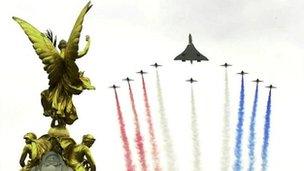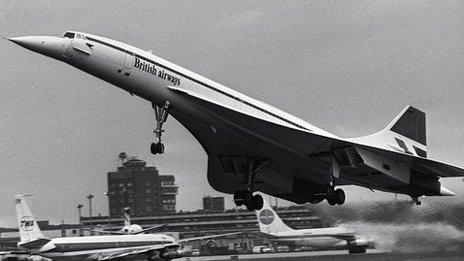Concorde engineer Sir Morien Morgan remembered on centenary
- Published
He's been referred to as Morgan the Supersonic, or the Welsh father of Concorde.
Some historians of one of the world's best-known aircraft have acknowledged that without the dogged persistence of Sir Morien Morgan it might never have got off the ground.
He was one of a group of brilliant young aeronautical engineers working at the Royal Aircraft Establishment (RAE) in Farnborough, Hampshire from 1935 where he specialised in aircraft control and stability.
In 1956, as chairman of the Supersonic Transport Aircraft Committee (STAC), he was in on the plan to build Britain's first supersonic passenger aircraft from the start.
In a post-war environment where aircraft design was changing, Morgan's task was to report on whether the next generation of passenger aircraft should be able to fly faster than the speed of sound.
He firmly believed it should and that building such a craft would boost Britain's national pride as a symbol of its technological competence.
STAC's report consequently set in motion a programme that resulted in Britain - in partnership with France - launching supersonic commercial flights on Concorde in 1976.
From the RAE, and later as a civil servant at the Ministry of Aviation, Morgan steered the project through its often turbulent evolution.
"He was involved in Concorde from the beginning," says Prof Deryn Watson, one of his three daughters.
"He made Concorde happen, basically. He brought everybody together to work together, the civil service and the engineers and unions, the French and the British.
'Technical success'
"That's a pretty unique achievement."
Morien Bedford Morgan was born in Bridgend on 20 December 1912.

Concorde led the flypast at the climax of celebrations for the Queen's golden jubilee in 2002
After attending schools in south Wales and England, he graduated from St Catharine's College, Cambridge in 1934.
Of his first 10 years at RAE his biographer EG Broadbent has written: "Many if not all of Britain's wartime aircraft were improved in their fighting qualities by application of Morgan's ideas and suggestions."
From the late 1950s onwards, continued Broadbent, Morgan "welded together a talented team and the remarkable technical success of Concorde owes much to him".
Morgan was involved in choosing Concorde's swept-wing design, a key part of its eventual success.
In 1964 he told the BBC documentary Supersonic: "It's a lovely shape - one feels that if God wanted aircraft to fly he would have meant them to be this shape."
"Concorde was very important to him," says Prof Watson. "He worked on the Spitfire in 1937/38 and he loved that too, but Concorde was his baby."
Prof Watson describes her father as "very direct and straightforward", traits which no doubt aided his stewardship of the project.
"He had no side to him," she says. "He got on just as well with the technicians and union members as he did with royalty.
"He always had a twinkle in his eye and smoked a pipe non-stop.
"He just loved airplanes. We would go on holiday and I'd end up wondering why we were sitting in a field having a picnic in some obscure part of Switzerland - it was because he wanted to watch some particular airplanes flying."
Knighted in 1969, Sir Morien became master of Downing College, Cambridge in 1972 but did not completely sever his links with the aeronautical industry. He died in 1978.
He is remembered at Cambridge by Prof Shon Ffowcs Williams, who himself worked on Concorde, as "an ebullient sort of a chap" who "would talk the hind legs off a donkey".
Dr Martin Mays, Fellow Emeritus at Downing, recalls him as "good company, particularly if one was interested in the Anglo-French co-operation involved in the construction of Concorde.
"He never tired of providing those willing to listen with anecdotes about the personalities involved and the many problems which arose."

British Airways' Concorde made its first commercial flight from Heathrow in 1976
As she recalls her father Prof Watson harks back to his younger days around the war.
"Between the 1930s and the 1950s there were a lot of significant men working at Farnborough," she says.
"They were young men at the cusp of a whole new world, at the cutting edge of aerodynamics at a time when there were so many exciting new possibilities.
"But they had fun. While at work they would lunch at the officers' mess and then race each other round the airfield in cars that they tinkered with.
"They were pushing the boundaries and they loved it."
- Published29 November 2012